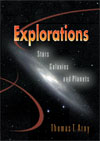Measuring the Properties of Stars 177 6.1 Measuring a Star's Distance 178 Measuring Distance by Triangulation and Parallax 178 Measuring Distance by the Standard-Candles Method 180 Extending Our Reach: Measuring the Distance to Sirius 181
6.2 Measuring the Properties of Stars from Their Light 182 Temperature 182 Luminosity 183 The Inverse-Square Law and Measuring a Star's Luminosity 183 Radius 184 The Stefan-Boltzmann Law 185 Extending Our Reach: Measuring the Radius of the Star Sirius 187 The Magnitude System 187
6.3 Spectra of Stars 188 Measuring a Star's Composition 189 How Temperature Affects a Star's Spectrum 190 Classification of Stellar Spectra 190 Re-Modeling: New Spectrum Classes 192 Definition of the Spectral Classes 192 Measuring a Star's Motion 193
6.4 Binary Stars 195 Visual and Spectroscopic Binaries 196 Measuring Stellar Masses with Binary Stars 197 Eclipsing Binary Stars 198
6.5 Summary of Stellar Properties 199 6.6 The H-R Diagram 199 Constructing the H-R Diagram 200 Analyzing the H-R Diagram 201 Giants and Dwarfs 202 The Mass-Luminosity Relation 202 Luminosity Classes 203 Summary of the H-R Diagram 204
6.7 Variable Stars 204 6.8 Finding a Star's Distance by the Method of Standard Candles 206 | 


 2002 McGraw-Hill Higher Education
2002 McGraw-Hill Higher Education